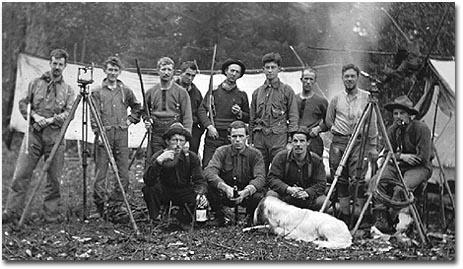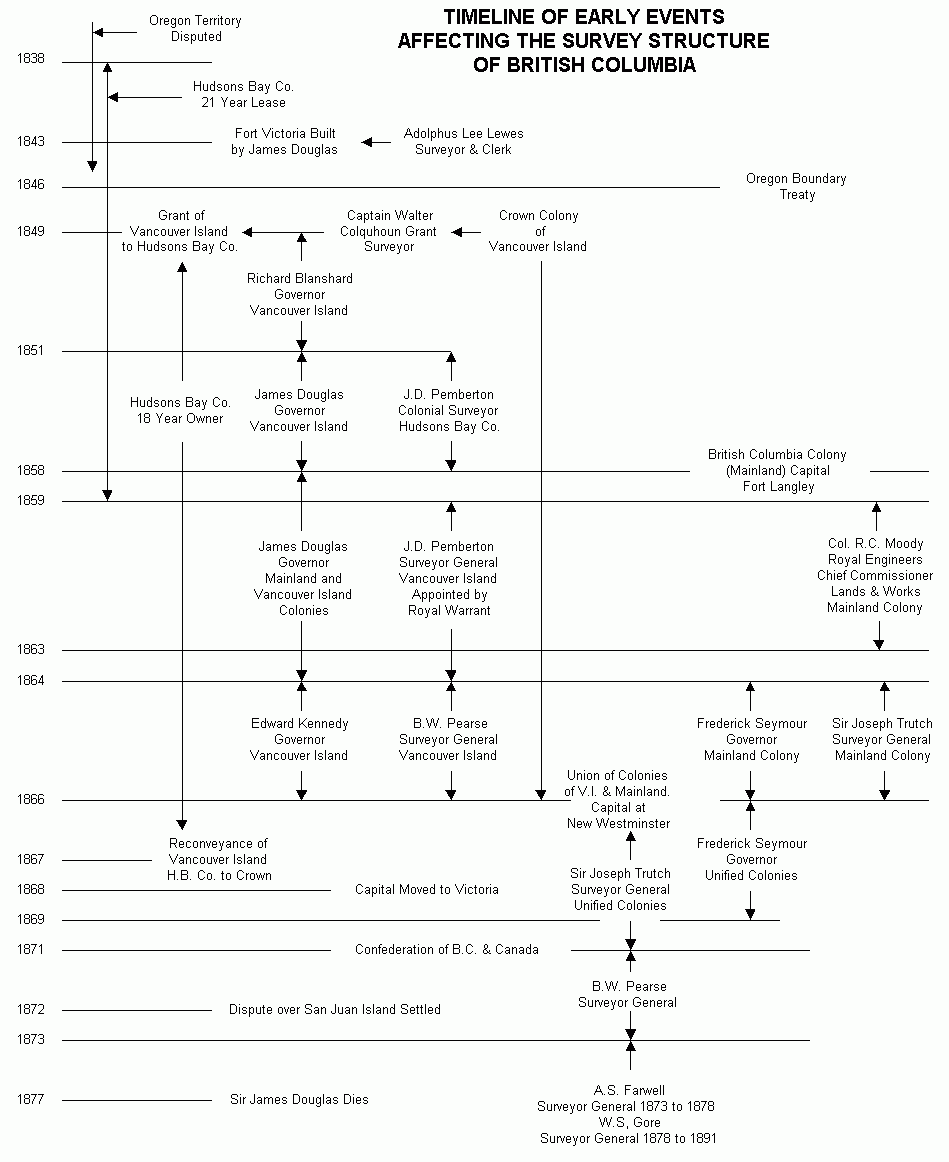History of the Surveyor General
Contents
History of BC’s Office of the Surveyor General
In 1851, the Hudson’s Bay Company appointed J.D. Pemberton as company surveyor. This event was instrumental in the creation of the first cadastral survey structure on Vancouver Island.
Pemberton remained with the company until 1858. In 1858, he was named, by royal warrant, the first Surveyor General of the Crown Colony of Vancouver Island. In the same year, Col. Richard Clement Moody, Royal Engineer, was selected for the office of the Chief Commissioner of Lands and Works as well as holding the commission of Lieutenant Governor of the mainland colony.
From 1864 to 1871, the Surveyor General was an elected official who held the title of Chief Commissioner of Lands and Works. In 1873, the Surveyor General’s function was detached from the Chief Commissioner’s role and became a position in its own right reporting to the Chief Commissioner. During this period, the Surveyor General was one of the most senior public servants in the province, being on par with the Deputy Attorney General. It is not difficult to understand the importance of the function, given the fact that BC was a new province opening up lands to settlers from both the rest of Canada and overseas, and that the Surveyor General was responsible for coordinating the settlement of the province.
In the first decade of this century, the Department of Lands was established, incorporating within its mandate, the Surveyor General’s office as well as Forestry and Water Rights responsibilities. The Surveyor General maintained responsibility for processing field notes and creating official plans which were submitted to government agents for Crown granting. The Surveyor General reported on the exploration by surveyors of the unsettled portions of the province and this exploration was utilized by government as a means of determining the natural resources and settlement potential of unexplored portions of BC. The Surveyor General was responsible for determining survey requirements for pre-emption (homesteading), purchases, mineral claims, coal licences and leases of Crown land. He was also involved in the determination of provincial boundaries and transportation issues (i.e. in advance of railroad development, adequate survey of land for settlement had to be provided).
By the 1920s, the Surveyor General was moving more and more away from resource issues to concentrating specifically on survey matters, both cadastral and control. During this period, fragmentation of responsibility for functions originally handled by the Lands and Water Department became more and more pronounced. The Forest and Water Branches developed separate reporting channels in the Department of Lands and the Departments of Mines, Highways and Municipal Affairs took over many functional responsibilities directly related to their areas of endeavour. Nevertheless, the land survey function was not fragmented as it was recognized that the need to standardize and maintain the quality of survey required that survey authority be vested in a single position.
In 1945-46, the Department of Lands and Forests was established with the Lands component comprised of Lands and the Survey and Water Rights Branches (including the Petroleum and Natural Gas Commissioner). Technological advances in air photography mapping were emphasized within the context of the Surveyor General’s mandate. The Surveyor General at this time was also the Director of Mapping and the Boundary Commissioner.
The organization and function of the Surveyor General’s office remained relatively constant from the 1920s until 1976. In that year, the Ministry of Environment was created and the survey function was split, with control survey and Boundary Commissioner responsibilities remaining with mapping and the Surveyor General retaining cadastral survey responsibility.
In 1978, when the Ministry of Lands, Parks and Housing was formed, the office of the Surveyor General was incorporated into the new ministry while surveys and mapping remained with Environment. As head of the Legal Surveys Branch, the Surveyor General reported to the Assistant Deputy Minister of Lands.
Due to internal restructuring, in 1979 the Legal Surveys Branch and portions of the Land Management Branch were combined to form the Surveys and Land Records Branch with the Surveyor General reporting to the Director of that branch. In 1981, the Surveyor General’s office was separated from the Surveys and Land Records Branch to perform a staff role in developing survey regulations and maintaining survey standards. The Surveyor General reported to the Assistant Deputy Minister of Lands.
In 1983, the Surveyor General’s office was once again incorporated into the Surveys and Lands Branch with the Surveyor General reporting to the Executive Director of the branch. This branch continued until 1985 when the role of Surveyor General was consolidated with that of the Director, to become Surveyor General and Director, Surveyor General Branch. At the same time, the role of Boundary Commissioner was returned to the Surveyor General.
In 1995, the position of Surveyor General and Director was divided with a branch reorganization. The Surveyor General managed the Office of the Surveyor General and reported to the Director of Crown Land Registry Services.
In 2001, the position was re-consolidated into Surveyor General and Director, Crown Land Registry Services.
In the fall of 2002, the Surveyor General Branch expanded to include responsibility for the Registry Data Section of the Ministry of Sustainable Resource Management which included spatial and attribute maintenance of forest, mineral and petroleum and natural gas tenures.
In the spring of 2004, the Ministry of Sustainable Resource Management announced the creation of a new independent Land Title and Survey Authority to improve and expand the province’s land title and survey systems. In January of 2005, the Surveyor General Branch became a part of the LTSA. Under the LTSA, the Office of the Surveyor General was known as the Surveyor General Division providing Surveyor General services, Crown grant services and records distribution services.
In 2019, following organizational changes at the LTSA, the Surveyor General Division separated into Policy and Operations Divisions. Today, the policy functions are carried out in the Policy and Legal Services Division, led by the Surveyor General, and operations functions are carried out in the Operations Division, led by the Senior Deputy Surveyor General.

Early Events that Affected the Survey Structure

List of Surveyors General of BC
Before British Columbia became a Province of Canada on July 20, 1871
- 1851-1858: Joseph Despard Pemberton “Colonial Surveyor”, Hudson’s Bay Co
- 1859-1864: Joseph Despard Pemberton, Surveyor General of Vancouver Island Colony
- 1859-1863: Col. Richard Clement Moody, Royal Engineer, “Acting” Surveyor General and Chief Commissioner, Lands and Works, British Columbia Mainland Colony
- 1864-1866: Benjamin William Pearse, Surveyor General of Vancouver Island Colony
- 1864-1866: Joseph William Trutch, Surveyor General of British Columbia Mainland Colony
- 1866-1871: Joseph William Trutch, Surveyor General of British Columbia (United) Colony
Surveyors General of the Province of British Columbia
- 1871-1872: Benjamin William Pearse
- 1873-1878: Arthur Stanhope Farwell
- 1878-1891: William Sinclair Gore
- 1891-1898: Tom Kains
- 1898-1905: William Sinclair Gore
- 1905-1912: Eric Barclay McKay
- 1912-1917: George Herbert Dawson
- 1917-1930: Joshua Edler Umbach
- 1930-1946: Frank Compton Green
- 1946-1950: Norman Charles Stewart
- 1950-1951: Frank Ormond Morris
- 1951-1968: Gerald Smedley Andrews
- 1968-1975: Arthur Herbert Ralfs
- 1976-1978: William Alfred Taylor
- 1978-1981: Ronald William Thorpe
- 1981-1985: Gerald Tudor Mullin
- 1985-1995: Donald Armitage Duffy
- 1995-1996: Patrick Brian Ringwood
- 1996-2002: Charles Hugh Nowell Salmon
- 2002-2007: Richard Thomas Hargraves
- 2007-2019: Michael Gordon Thomson
- 2019-Present: Cristin Rae Schlossberger
